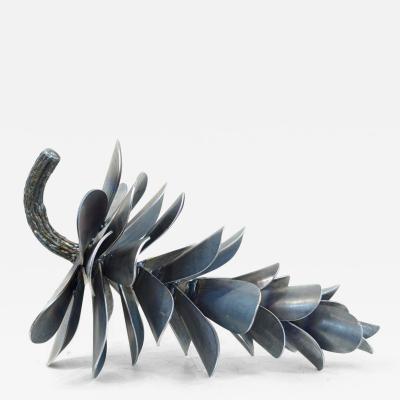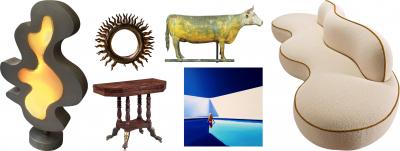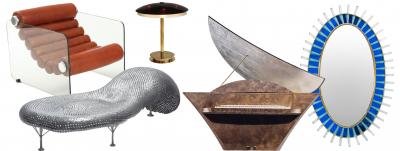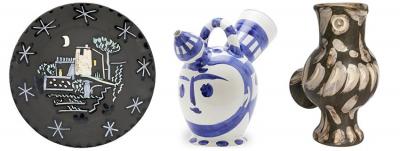Take a Seat! The Humble Chair as a Work of Contemporary Sculpture
 |
by Benjamin Genocchio
 |
he chair is a humble object — utilitarian and commonplace. Design historians tell us that chairs only came into widespread use in Europe in the 16th century, for up until that point people largely sat on benches or stools. The word chair itself is a derivation of a conjunction from the Latin words ‘to sit’ and ‘down.’
Chair design has evolved dramatically over the centuries — a desire for comfort, most importantly, led to the invention of upholstered chairs in the 17th century. Before then people used cushions on hard benches and chairs, if they were lucky enough to have a seat, as chairs were initially reserved for royalty, particularly as ceremonial furniture.
Computer imaging technology coupled with new materials and production processes have enabled designers to conceive of increasingly radical concepts for chairs. Today, chairs have come to be considered more than merely functional, they are beautiful, sculptural works of art in and of themselves. There are no limits to contemporary chair design.
Here, we take a look at 8 sculptural chairs that double as works of art.
 |
 |
Exclusive to Galerie BSL in Paris, internationally renowned artist Pia-Maria Raeder’s Stardust Bench twinkles and glitters with cosmic reflections in a spectrum of warm tones from brown to pink to golden, to cooler tones of blue, black and silver. Dome-shaped beechwood “pearls” are carved to different dimensions and are painstakingly hand-applied one-by-one by the artist, encrusting the surface and animating the organic form. |
Stardust Bench Ensemble
by Pia-Maria Raeder
German artist Pia-Maria Raeder has produced one of the most startlingly innovative seating designs in recent memory with her Stardust Bench Ensemble, a pair of benches with two seats each, encrusted with 23,000 beechwood half “pearls.” Each pearl is individually applied by hand on a waxed concrete structure and finished with a coating of silver, to create a shimmering, sparkling, reflective surface that varies in appearance depending on the angle from which it is viewed. The artist explains her inspiration for the work as a fascination with the wider cosmos. “Just like everyone I am fascinated by the scene of a starry sky. We all instinctively feel the magnetic attraction of these suns’ final splendors, as far as they may be. Living organisms are all made of this stardust that has crossed the universe for billions of years. With Stardust, I want to give my own interpretation of this natural phenomenon.” Each piece is handmade by the artist and is unique.
 |
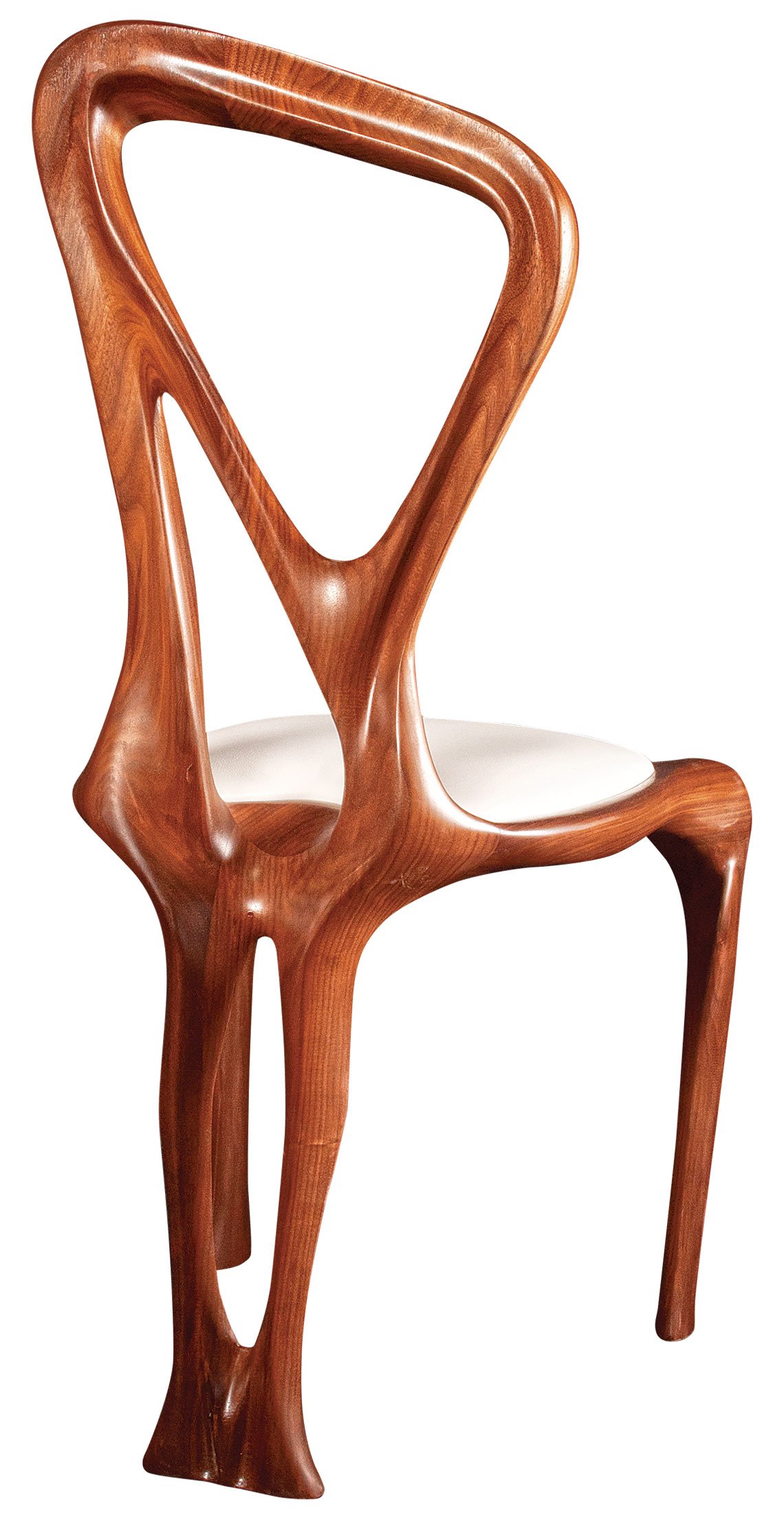 | Gazelle Dining Chair by Amorph The Gazelle Dining Chair in walnut wood and natural stain is a wonderfully organic design that from the back angle looks like a gazelle standing on alert. The nimble, sinuous legs anchoring the chair back converge at the bottom into one, heightening a sense of this sculpture as modeled on the fast-moving, elegant member of the antelope family. The slender, sleek elongated lines of the back and legs certainly heighten the association. “The Gazelle Chair design challenges the traditional idea of stability of a chair by having 3 legs and with overall an organic shape,” says Amir Habibabadi from Amorph. The chair is made to order of carved wood in the United States and is available in numerous different finishes. | |
| Inspired by the nimble grace of the gazelle, Los Angeles-based Amorph design atelier created the Gazelle Dining Chair to be perfectly comfortable as well as strikingly elegant from every angle. The seatback is composed of contoured open forms, with rear legs flowing into a gently flared conjoined base, an undulating, organic sculpture that is a work of functional art. |
 |
Shelly Chair by Peter Donders Belgian designer Peter Donders has created a piece of pure sculpture which is also secondarily a chair, in short, a work of collectible design that is functional. Created in 2021, Shelly resembles a piece of rope bent and coiled into the shape of a chair — it is sinuous and flowing, fluid and taut at the same time. The design process is fascinating, for the object is produced initially with the aid of a 3D printer and then die-cast in bronze. Erik Müllendorff from 88 Gallery in London, explains the process in more detail: “Shelly by Peter Donders is a one surface (shell) cast from a 3D print. Based on the 3D print, a mold is made to cast the chair, but only the contours of the chair are cast. The shape is suggested by its outer shell. Shelly is a supreme example of how digital technology and craft can blend together.” |  | |
88 Gallery believes that the best of collectible design combines innovation in form with the age-old properties of matter, and the work of Belgian artist Peter Donders echoes that tenet. His Shelly sculptural chair is a brilliantly successful example of how technology and traditional craftsmanship work together. Designed with a 3D printer, which frees the artist to stretch creative boundaries in form, the work is then produced with traditional casting techniques and hand finished. As Donders proclaims, “It’s still a manual labor of love.” | ||
 |
 |
Brazilian design has never been hotter, and Equinoctial, with galleries in Boca Raton, Florida and The Gallery at 200 LEX powered by Incollect has a spectacular work by contemporary Brazilian designer Guto Indio da Costa. His Jequitibá Wood Chaise Longue from the Machina&Manus Collection was created as an exploration of the nexus of human, handmade creation and digital technology manufacturing processes. The digital process allows sculpting to an extreme while maintaining accurate ergonomics, and the piece is completed with the highest standard of artisanal craftsmanship in a methodology the designer describes as “techno-organic” design language. This work is both a nod to the tradition of fine Brazilian craftsmanship and an acknowledgment of the limitless possibilities with advanced design technology. |
Jequitibá Wood Chaise Longue
by Guto Índio da Costa
The contemporary Jequitibá Wood Chaise Longue by Brazilian designer Guto Indio da Costa is infinitely cool, an amazing piece of contemporary furniture design as sculpture. “It has a sculptural form,” says Marcelos Vasconcellos, a partner at the Mercado Moderno Gallery (MEMO) who represents the artist. “It is exuberant, a continuous sequence of complex surfaces. Minimalist and sensual, and impeccably produced by the sum of digital and handcrafted manufacture.” Designed in 2019 it is also unique, each piece made to order, which is saying something in contemporary design. The pieces are expertly made in collaboration with San German, a Brazilian manufacturer known for high-end finish carpentry. It is smooth, sexy, sinuous, and comes in several finishing options including natural, whisky, nogueira (walnut), dark walnut and painted black. It is also supremely comfortable. This is a timeless, elegant work of art.
 |
 |
Valerie Goodman Gallery in New York represents the work of French sculptor and designer Jacques Jarrige, and one his most intriguing pieces is the Aubrac loveseat. In a form that is primal and innocent, and at the same time earthy and sensual, it is a study in contrasts. Jarrige is known for his use of humble materials, and in Aubrac the humble component is layered cardboard which is reinforced with a strong aluminum structure. There is, however, nothing humble about its appearance; Jarrige lavishes his works with meticulous and patient hand shaping and the piece has a burnished glow, rich and deeply seductive. |
Aubrac Sculpted Sofa/Loveseat
by Jacques Jarrige
Valerie Goodman Gallery, New York
“The objects of Jacques Jarrige are always animated, in a reassuring way, to provide a renewed sense of discovery,” says Valerie Goodman, speaking about the Aubrac sculpted sofa/loveseat in her gallery by the Paris-based contemporary sculptor and designer. “The sculpted Aubrac sofa with its subtle anthropomorphic form, generous and taut, gives the impression it has always been here, in our home, functional and jubilant.” The piece is dark, smooth and shiny, like ebony. The sensuous, sinuous structure, devoid of visible joins, is wonderfully dynamic and fluid, giving off the impression of flowing liquid or constant movement. The piece was designed in 2018 and although it looks as if it were made from a single piece of carved wood, it is actually constructed by hand of layered cardboard set over a strong, finely sculptured aluminum structure, sanded smooth and then lacquered.
 |
Meltdown Chair: Bronze #1 by Tom Price British artist Tom Price has made a conventional chair in an unconventional way. His Meltdown Chair: Bronze #1 is made with the lost wax technique, traditionally used for casting bronze. In this case, it is made using plastic tubes as the basic form for the chair, which is then covered in ceramic and then heated at high temperature so the plastic is melted out to create a mold into which the molten bronze is poured to create the final chair. Stefan Lawrence, the founder and director of Twentieth Gallery, considers the artist’s technique to be completely innovative in chair design. “Tom’s conceptualization of melting down common plastic items to form this series of chairs was groundbreaking.” He also feels this current chair builds on previous experiments with casting furniture in a similar manner. “This bronze version brings a more heroic quality and presence than the previous incarnations.” Price leaves the back and the underside a patinated black, while the seat is polished to create a gold bronze glow. Tom Price is a member of the commonplace materials/high design tribe which includes devotees such as the Campana Brothers, and clearly likes melting things, as previous pieces involved exposing plastic rope, PVC hoses and fleece jackets to extreme heat. The Meltdown Chair: Bronze #1 advances the form to a far more refined standard, the noble material of bronze conveying both classical associations and timeless elegance. Offered by Los Angeles gallery Twentieth, a leader in the presentation of cutting-edge collectible design. |
 |
 |
Represented by Maison Parisienne, 32-year-old artist Pierre Renart is a master cabinetmaker, fully in command of his medium and the endless possibilities for manipulating wood into forms seen first as sculpture, which then reveals itself as furniture. His Möbius Bench is ribbon of teak, winding around itself with no beginning and no end, a sculptural metaphor for infinity and perhaps the perfect seat for meditation and inspiration. |
Möbius Bench
by Pierre Renart
The Möbius Bench is French designer Pierre Renart’s first artwork for the outdoors, but it can easily be used indoors as well — a trend in contemporary design in which distinctions between indoor and outdoor furniture are less relevant. Designed in 2020, this elegant, functional teak bench, precise and sensual, has its origins in mathematics; the piece is inspired by the work of mathematician August Ferdinand Möbius and his famous, eponymous geometrical shape. “The Möbius Bench is part of the Ruban (Ribbon) collection,” says Clélia Boissiere from Maison Parisienne. “Giving the illusion of an endless strip of teak wood, the Möbius Bench is altogether very technical, sculptural but also functional as it lends perfectly for all kinds of purposes.”
 |
Son of Atlantis Chair by Mark Brazier Jones Mark Brazier-Jones Ltd, Buntingford, England The Son of Atlantis chair, available in bronze (patinated or polished finish) or in aluminum, is an unusual, unique contemporary chair which is actually a reimagining of an earlier limited edition sculptural chair now in the collection of The Victoria & Albert Museum in London. The original design, the Atlantis, sold out almost as soon as it was created in 1988, reinforcing the allure of the design. “Clients kept begging Mark to make more…eventually he conceded adding balls to the feet and allowing it to be an open edition,” a representative for Mark Brazier-Jones Ltd. said, “thus giving all those fans who had lost out on the first incarnation an opportunity to own a piece of sculptural art. In short, it was our clients who told us it was such a wonderfully special and creative piece, and therefore holds a place in our hearts.” New Zealand-born Mark Brazier-Jones creates his visionary art at his farm/studio in rural Hertfordshire, one hour north of London, and a million miles away from the ordinary. His work is sought by rock stars, movie stars and art collectors around the world. His Son of Atlantis chair draws upon classical, futuristic and mystical inspirations, and shows his interest in timeless historical motifs. The wings and hoofed legs allude to French Empire furniture which was often embellished with animal-form gilt bronze mounts; the curved rear saber legs were seen in chairs from that period as well, and while undeniably flamboyant, is a comfortable and functional seat. |



















